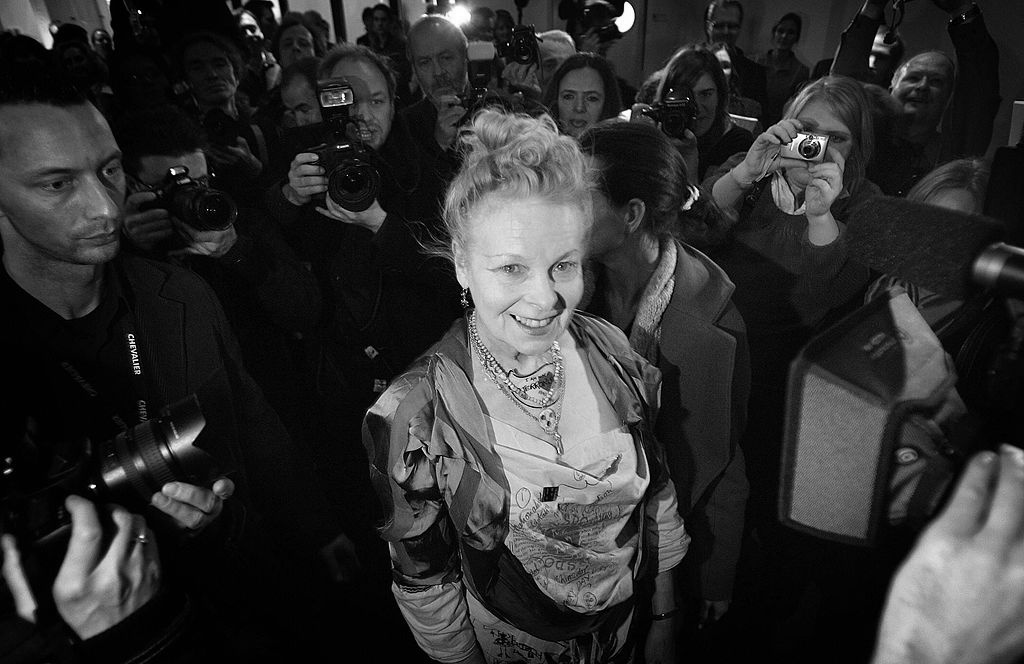Seeing the swathe of superlatives wheeled out about Vivienne Westwood after her death last year at the age of 81, it felt for a moment like Elizabeth the Great had died all over again. Acolytes from Victoria Beckham to Sadiq Khan delivered their fawning tributes – my favourite was from Bella Hadid, who lamented the loss of ‘the most epic human being that has walked this earth.’ But the two women, Queen Elizabeth and Westwood, were as different as chalk and cheesecloth. The designer was a graceless, grasping woman, with an opinion – always wrong – about everything. No matter how much she complained and explained, she never convinced me that she was anything more than a hyped-up hustler.
Being greedy and being stingy often go together; stinginess is the halitosis of the soul
Westwood was a hypocrite. At her 2013-14 runway show the audience found her Climate Revolution manifesto printed on the back of the show’s production notes. ‘Capitalism is as corrupt as a rotten apple… U accept because u think there’s no alternative. But we have hope (war is fought 4 land + cheap labour). Change the economy – NO MAN’S LAND. Start by renting use of land, ocean + air – target: sustainability + peace.’
What a shame, then, that for a long time Westwood received the dubious honour of having the lowest rating possible for environmental sustainability on Rank A Brand, the non-profit foundation which compared the carbon footprint of leading fashion, food and homeware manufacturers, noting that her favouring of PVC, plastics, and petrol-based polymers was especially damaging – as well as the fact that many of her clothes were made in China, which is known for its sweat-shop labour. By the time Rank a Brand was incorporated into the similarly-intentioned Good On You – ‘Creating a world where it’s easy for anyone, anywhere to buy better’ – the Dame had been promoted to the status of ‘It’s a start’. But not much of one: ‘There is no evidence it ensures payment of a living wage in its supply chain.’ To be fair, Westwood seemed to partially comprehend her own duplicity: questioned by Carole Cadwalladr in the Guardian about what Suzy Menkes of the International Herald Tribune had written about her (‘How dare she send out a show laced with anarchist messages, announce that the spirit of her show is “the more you consume, the less you think” and then take the opportunity to launch her collection of punk safety pins in diamonds?’) she could only come up with ‘I don’t feel very comfortable defending my fashion except to say that people don’t have to buy it. You do have to consume. You have to live. If you’ve got the money to be able to afford it, then it’s really good to buy something from me’.
Being greedy and being stingy often go together; stinginess is the halitosis of the soul. A fashion insider told me ‘She was once offered corn-made packaging garments bags which dissolve naturally – and she declined as it was slightly more expensive than plastic packaging.’ (Mind you, Westwood didn’t love allplastics; an item on Popbitch recalls her overheard in a theatre chiding her husband as he returned from the bar ‘Really darling, do they not have glassware here? Or am I expected to drink wine from a plastic cup?’) I’ve heard so many clowns say ‘She was never interested in money’ which is like saying that I’m not interested in vodkatinis. Publication of company accounts in 2015 revealed that she was sending £2 million a year to an off-shore account in Luxembourg; a friend says ‘I remember a mate of mine years ago making her corsets in her bedsit that were sold at the time for several hundred pounds. She got £15 per corset.’ No wonder she left an estimated £150 million fortune.
But for me, the worst thing about her was her intern programme which meant – for all her blather about revolution – that only the children of the wealthy could work for her as she paid them nothing. Fashion to some extent runs on an ‘economy of hope’ with interns thinking ‘if I do this job for nothing and I do really well, maybe I’ll get noticed and actually put on the payroll at some point’. How cruel to exploit the dreams of the young – and to make it possible only for rich kids to get a start.
Westwood passed as clever only because fashion folk are so thick. I spent some time around them in my twenties when my new husband’s two best friends were the boyfriends of Katharine Hamnett and Isabella Blow and it was quite the eye-opener – or rather, eye-closer. I grew up in the less than intellectual world of rock music as a teenage reporter, but fashion people make pop stars seem like rocket scientists; hearing the Ramones attempt to converse was like being at the Algonquin Round Table in comparison. All my life I’ve loved the company of my fellow hacks, more than drink and drugs even, but I was amazed how the addition of the word ‘fashion’ in front of ‘journalist’ instantly transformed a potential fun new friend into an ocean-going ninny entirely capable of using words like ‘genius’ about a blouse. The way rag trade types talk about clothes ‘expressing your personality’ is a giveaway: most of us express our personalities through speech and action and a thing called wit. This sojourn led me to the conclusion that those who care about clothes really are the dullest people in the world, and this is why their elaborate window-dressing is so important to them.
Oscar Wilde wrote that ‘Fashion is a form of ugliness so intolerable that we have to alter it every six months’. Westwood couldbe a good designer when she put aside any idea of being an artist, but like a lot of people who spent too long at art school she thought it shameful to be just a dressmaker. Her dresses weren’t made for the usual stick insects gay male designers tend to favour, which made women pathetically grateful to her. But all the ‘strong woman’ tributes ring somewhat hollow for a woman who at the start of her career made CAMBRIDGE RAPIST T-shirts and towards the end was Julian Assange’s chief groupie. John Lydon put it well, with characteristic insight, calling Westwood and Malcolm McLaren ‘a pair of shysters – they would sell anything to any trend that they could grab onto.’
Westwood was fashion’s sacred cow, but such gushing adulation as we witnessed on her death is just so un-punk,for want of a more elegant phrase. She wasn’t a rebel; rebels don’t accept OBEs, rebels don’t avoid tax, rebels don’t have interns work for free. Rather, she was a dull person’s idea of an interesting person. A message posted on her official Twitter page read ‘The world needs people like Vivienne to make a change for the better.’ No, we don’t. Because it wasn’t only when she went knicker-less to Buckingham Palace to accept her honour that this empress had no clothes.







Comments